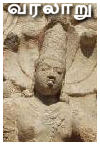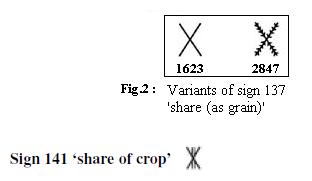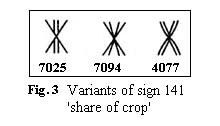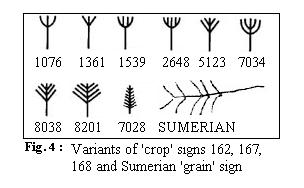 |
 |
 |
http://www.varalaaru.com A Monthly Web Magazine for South Asian History [187 Issues] [1839 Articles] |
 |
 |
 |
http://www.varalaaru.com A Monthly Web Magazine for South Asian History [187 Issues] [1839 Articles] |
|
Issue No. 37

இதழ் 37 [ ஜூலை 16 - ஆகஸ்ட் 15, 2007 ] 
இந்த இதழில்.. In this Issue.. 
|
Introduction 1. The Indus or Harappan Civilization was based on agricultural surplus like all other contemporary river-valley civilizations of the Bronze Age. The annual flooding in the Indus and the rivers of the Punjab brought down rich silt making irrigated lands very fertile. There must have existed administrative machinery to collect the grain as taxes due to the State or offerings to the temples. The grain would have been stored in large granaries for distribution as wages, especially to the army of workers employed in the construction of massive public works like the brick platform at Mohenjodaro, fortifications at Harappa, city drainage systems, irrigation canals etc. 2. It would have been convenient to control the apportionment of grain right at the threshing floor. Sheaves of grain stalks would have been bundled into lots and marked with clay tags which were then impressed with seals to identify ownership before the grain was transported to granaries or taken away by landlords as their share, leaving the rest as the share of tenant-farmers or wages to the cultivators. 3. It is thus quite likely that Harappan seals and sealings would contain information on agricultural production and distribution. This probable scenario has led me to search for and identify a remarkable set of closely knit signs which appears to refer to crops and sharing of grain. (Text Numbers, Sign Numbers and statistics are cited from my book, The Indus Script: Texts, Concordance and Tables 1977. Four-digit numbers refer to texts and three-digit numbers to signs. The Sign List and List of Sign Variants in the book are the sources for illustrations.) Methodology 4. The proposed interpretations are based on the pictorial character of the signs and their probable functions as determined by positional and statistical analysis of the texts. As the 'rebus' principle is not invoked in this study, there is no need to make any assumption about the language of the texts. I have, however, chosen to cite, wherever apt, bi-lingual (Dravidian and Indo-Aryan) parallels relating to agriculture, as I believe that they represent age-old traditions at the ground level and that they lend support to the proposed ideographic identification of the signs. Agricultural Terms in the Indus Script (Chart) 5. The appended Chart illustrates a set of closely related signs interpreted as 'agricultural terms'. The signs are arranged in a grid of columns and rows to bring out their similarities and inter-relationship. It is remarkable that the entire set of agricultural terms is made up of just three 'basic' signs combining with five 'modifiers'. The basic signs are placed at the head of the three central columns (I to III). The modifiers are listed one below the other in the first column at the left. They consist of three modifying 'elements' (labelled A to C) and two modifying signs. The modified compound signs are placed at the junction of the respective columns and rows. The meanings of the basic signs and the modifiers are given in the Chart. The meanings of the compound signs are derived by the combination of the respective modifier and basic sign. Interpretation of Basic Signs 6. The basic signs, especially their graphic variants, provide the pictorial clues to their identification as explained below.  7. The point of departure for this study is the X-like sign 137, one of the simplest in the Indus script. It invites comparison with the near-identical ideogram in the Egyptian hieroglyphic script which means 'to divide'. The comparison enables us to assign the same general meaning to the corresponding Indus sign, 'to divide, share' (Fig.1).  8. The next clue as to what is divided as shares comes from two identical texts on a pair of three-sided prism-like sealings (1623 & 2847) from Mohenjodaro. These are incidentally the longest known Indus texts, each consisting of 26 signs. While all but one of the signs are identical in the two inscriptions, one sign alone (137) shows an interesting variation providing a precious clue to its meaning. The graphic variant in 2847 shows a pair of stalks laden with grain arranged in X- like form to mean 'share (as grain) ' (Fig.2). Sign 137 and the modified compound signs derived from it (in col. I of the Chart) also have other minor graphic variants, where the straight X-like lines are replaced by curved lines suggestive of slender and supple grain stalks (e.g. 1179 & 6131).  9. This more elaborate sign can be interpreted as a combination of the X like element 'to share' with a pair of tall vertical lines representing 'grain stalks', the whole sign having the meaning 'share of crop'. The proposed identification is supported by the graphic variants of the sign, which suggest 'bundles of grain stalks tied in the middle' (Fig.3). The modified compound signs derived from sign 141 (in col. II of the Chart) also have similar variants (e.g. 2098, 3107 & 4077).  10. Many Dravidian languages have specific expressions for 'share of the crop', which are derived from the verb 'to gather, make into bundles, carry away'; (e.g.) Verbs: Ta. va$ru 'to take by handfuls'; Ma. va$ruka 'to take in a heap'; Ka. va$me 'heap of straw'; Te. va$ru 'to make into a bundle (of hay)'; Malt. ba$re 'to take out as grain' (DEDR. 5362). Nouns: Ta. va$ram 'share, lease of land for a share of the produce, share of the crop of a field'; Ma. va$ram 'share, landlord's share'; Ka. va$ra 'share, landlord's half-share of the produce of a field in lieu of rent' (DEDR 5359). Cf. Ta. va$ri 'produce, grain' (Tamil Lexicon). Also see the discussion below on Ta. me$l-va$ram 'landlord's share of the produce' and kut|i-va$ram 'tenant's share of the produce'. The pictorial depictions in the corresponding Indus signs are in close accord with the imagery invoked by the Dravidian expressions cited above.  11. Sign 162 is a self-evident ideogram for 'crop' as may be seen from its graphic variants (including signs 167 and 168 now recognized to be mere variants of 162). The sign may also be compared with the identical Sumerian 'grain' sign (Fig. 4).  The realistic depiction of the 'crop' sign in the more recently discovered seals from Banawali is conclusive evidence for the proposed identification. (See especially B-12 in Corpus of Indus Seals and Inscriptions, vol. I).The similar manner in which modifiers are added to this sign like the other two basic signs lends additional support to its identification. The most common expression for 'crop' in Dravidian languages is vil|ai (v.) 'to be produced'; (n.) 'produce, crop, yield' (DEDR 5437). Modifiers and Compound Signs  (To be continued ... ) this is txt file� |

சிறப்பிதழ்கள் Special Issues 

புகைப்படத் தொகுப்பு Photo Gallery 
|
| (C) 2004, varalaaru.com. All articles are copyrighted to respective authors. Unauthorized reproduction of any article, image or audio/video contents published here, without the prior approval of the authors or varalaaru.com are strictly prohibited. | ||